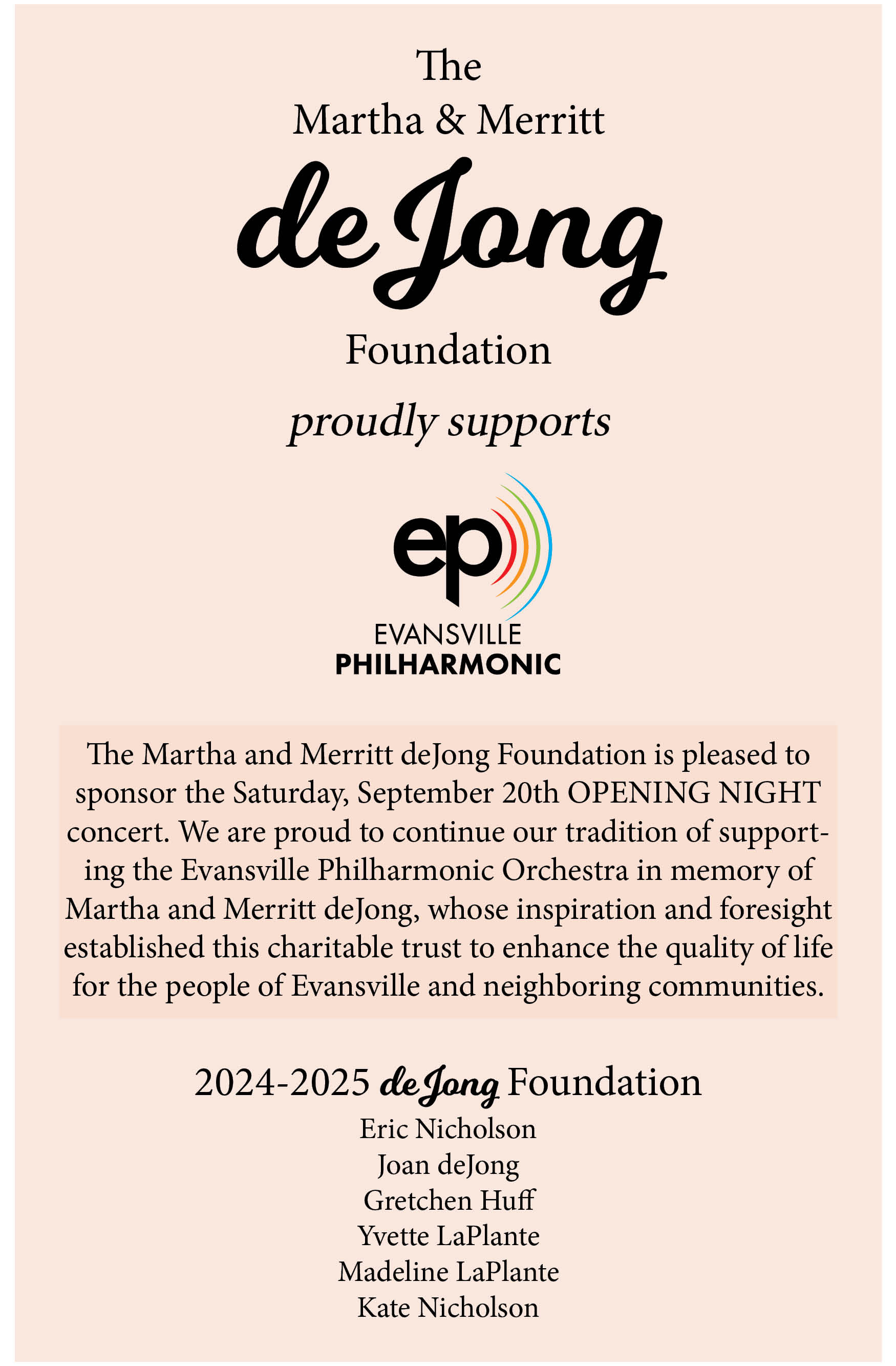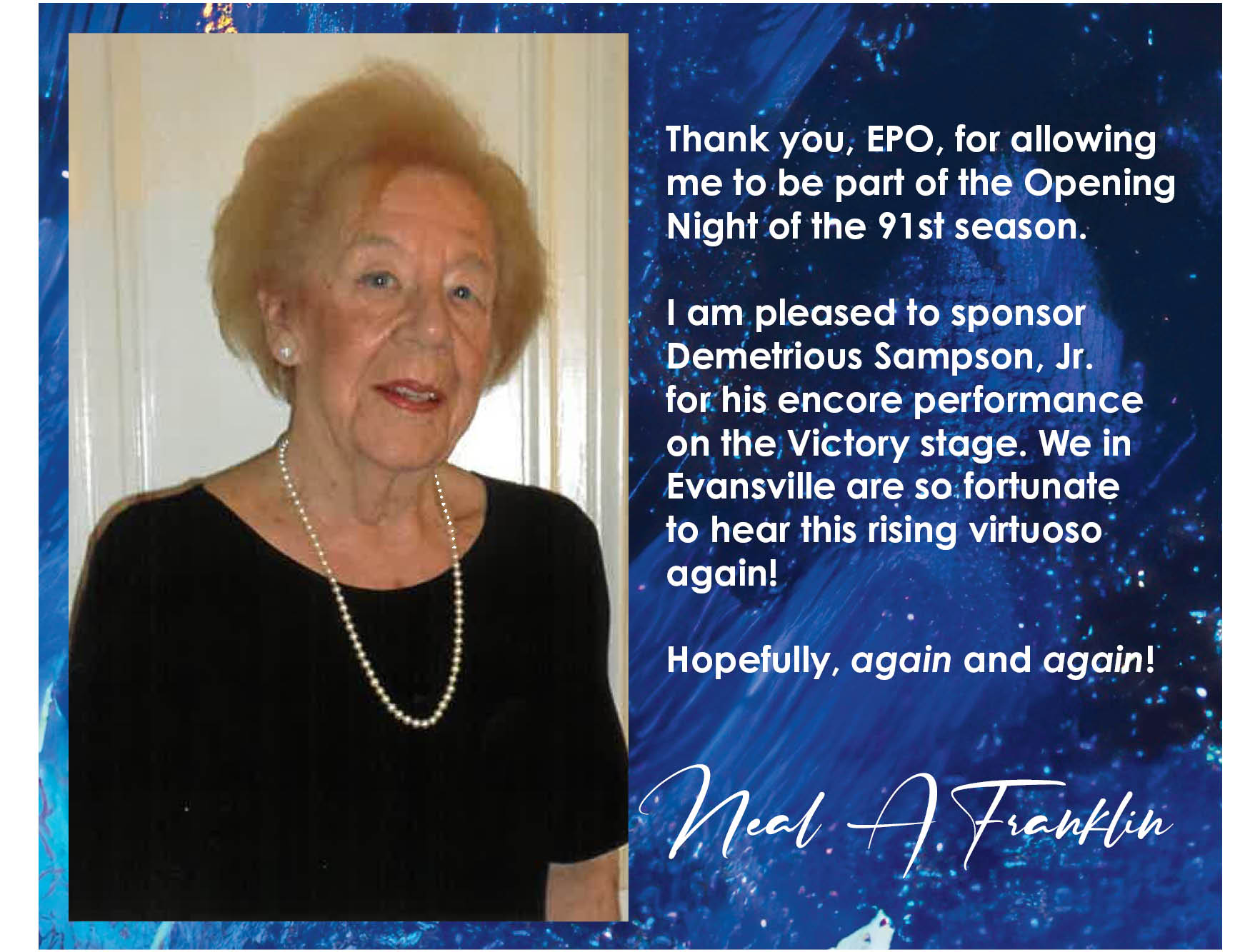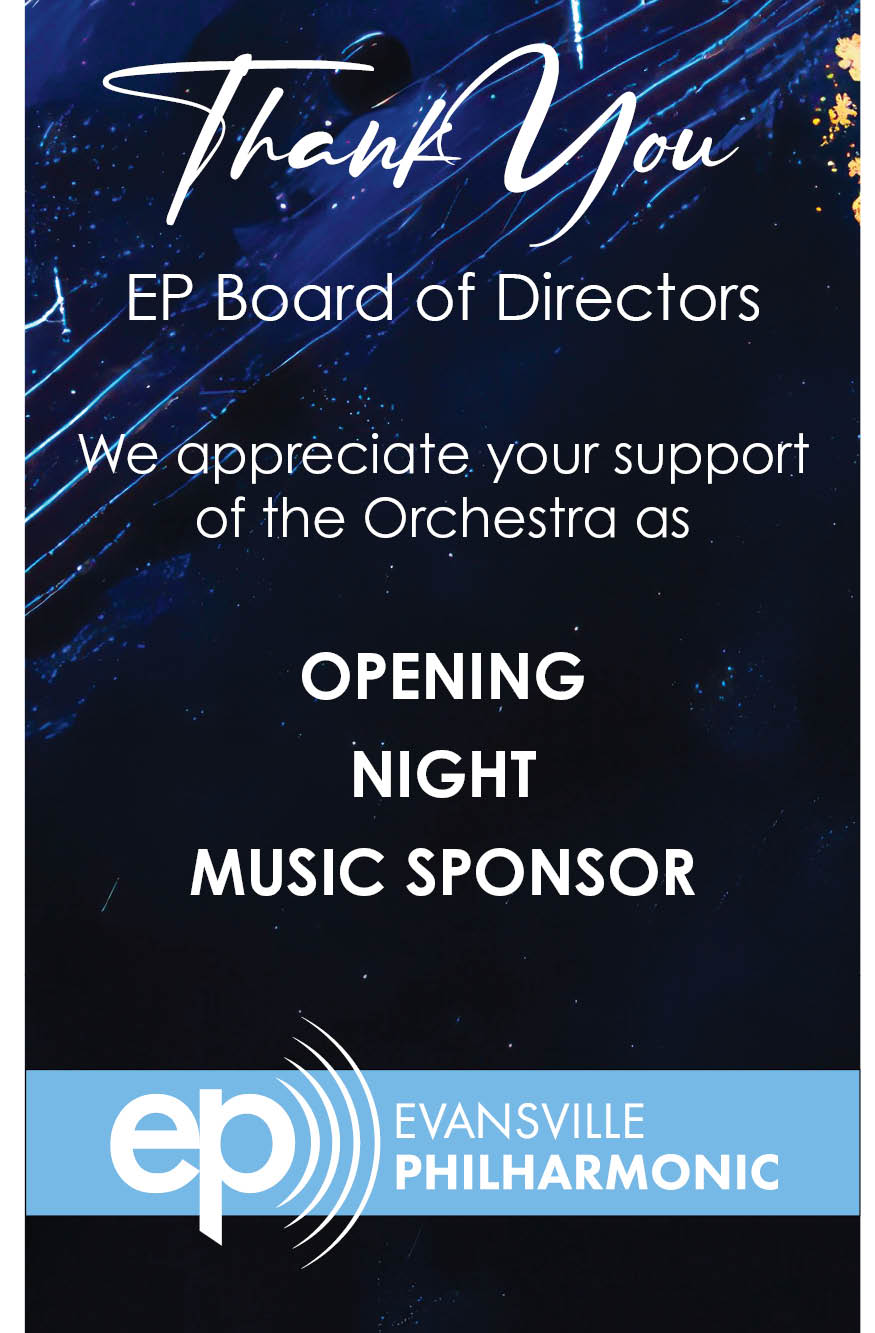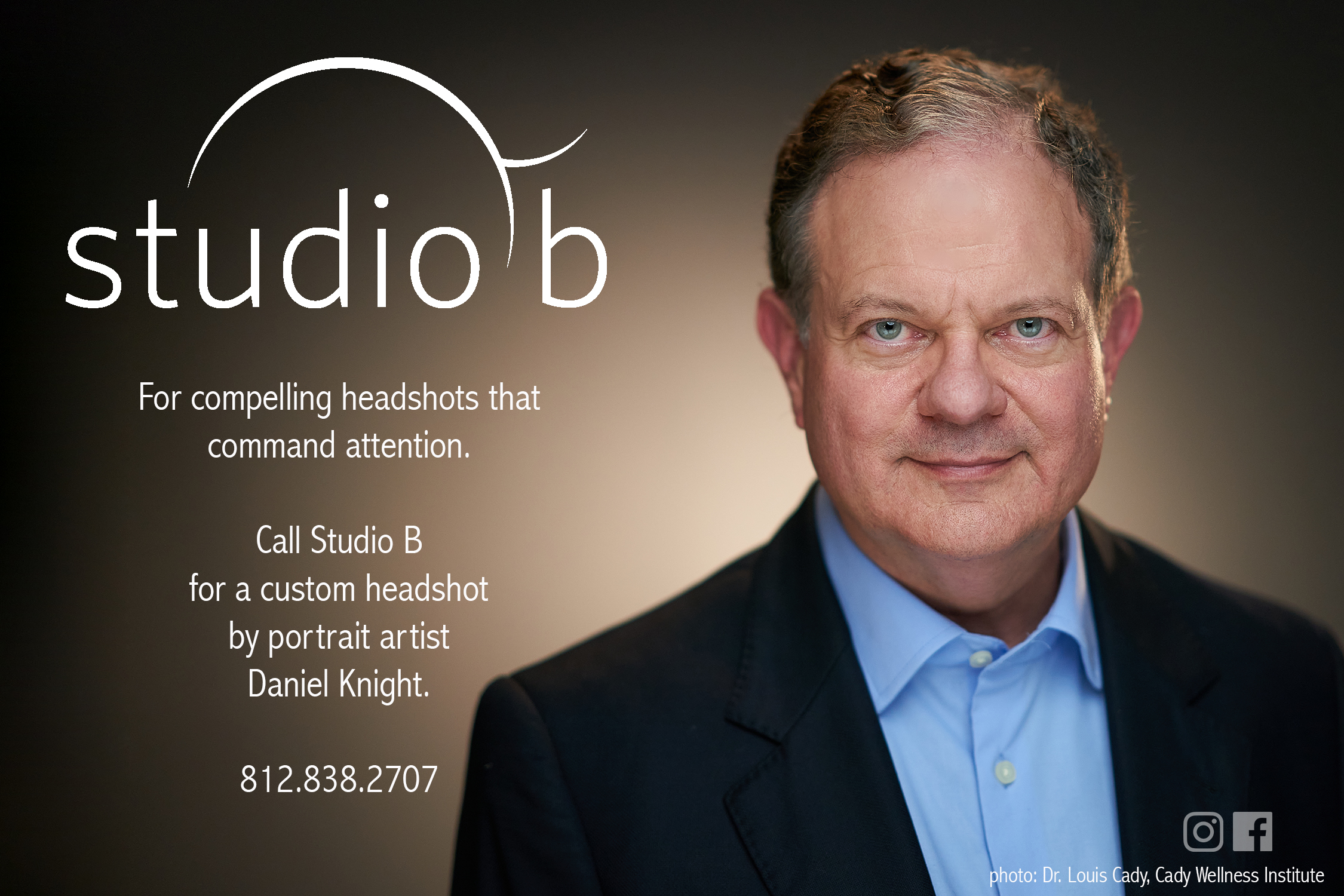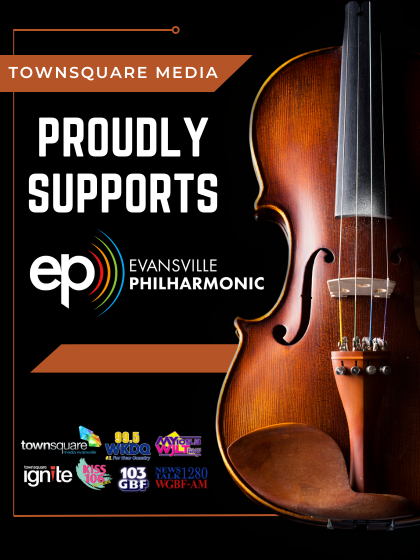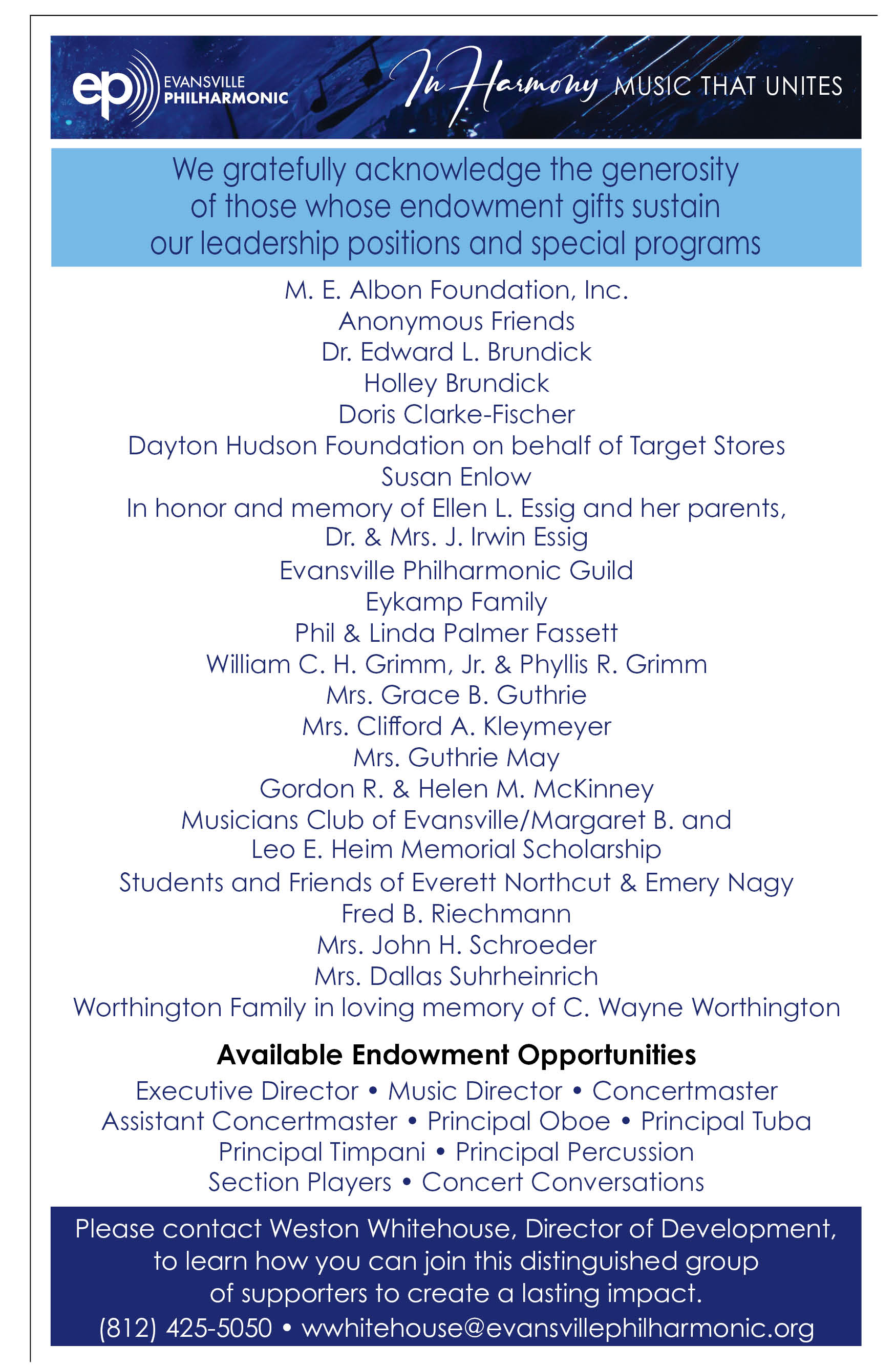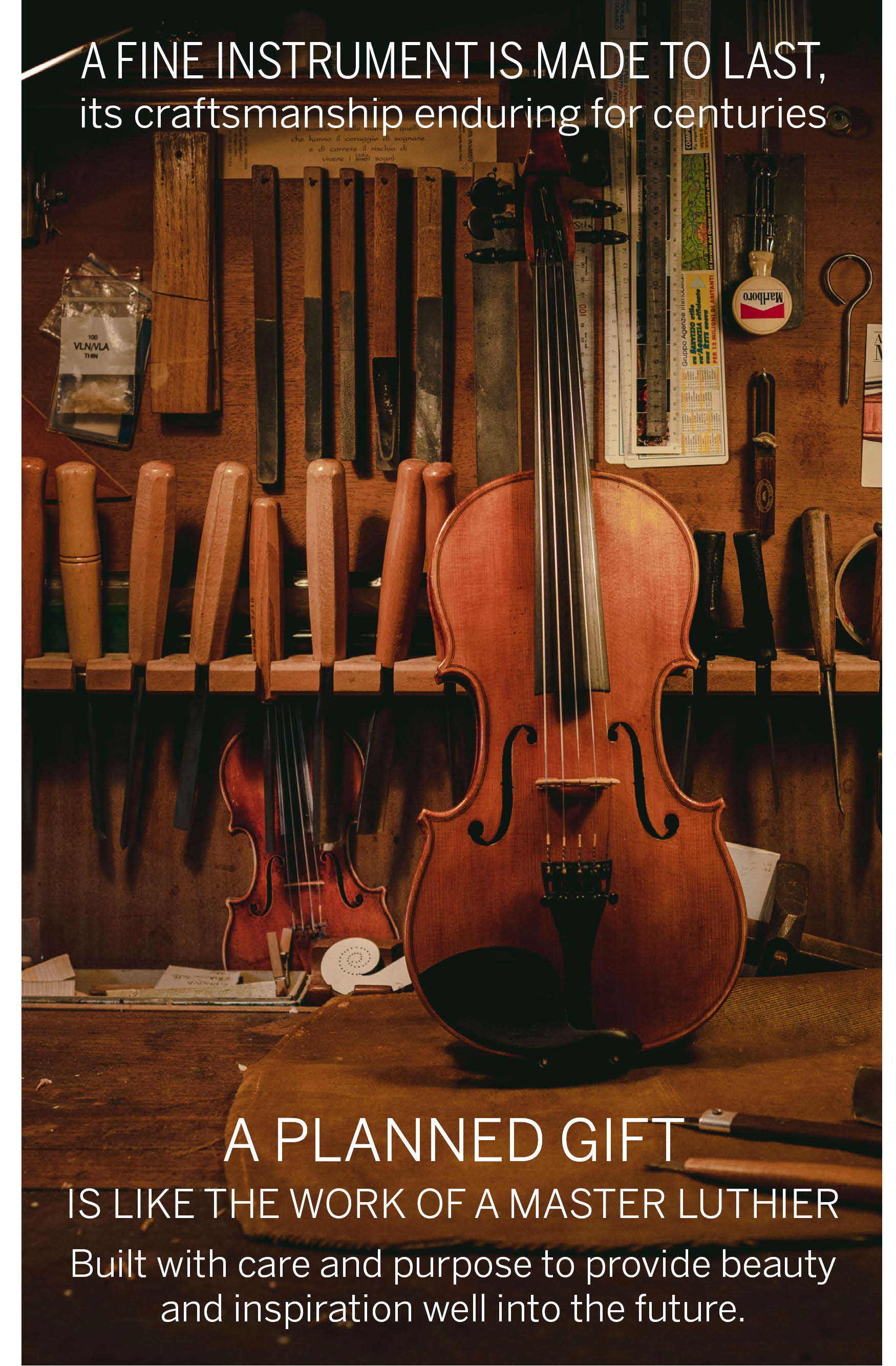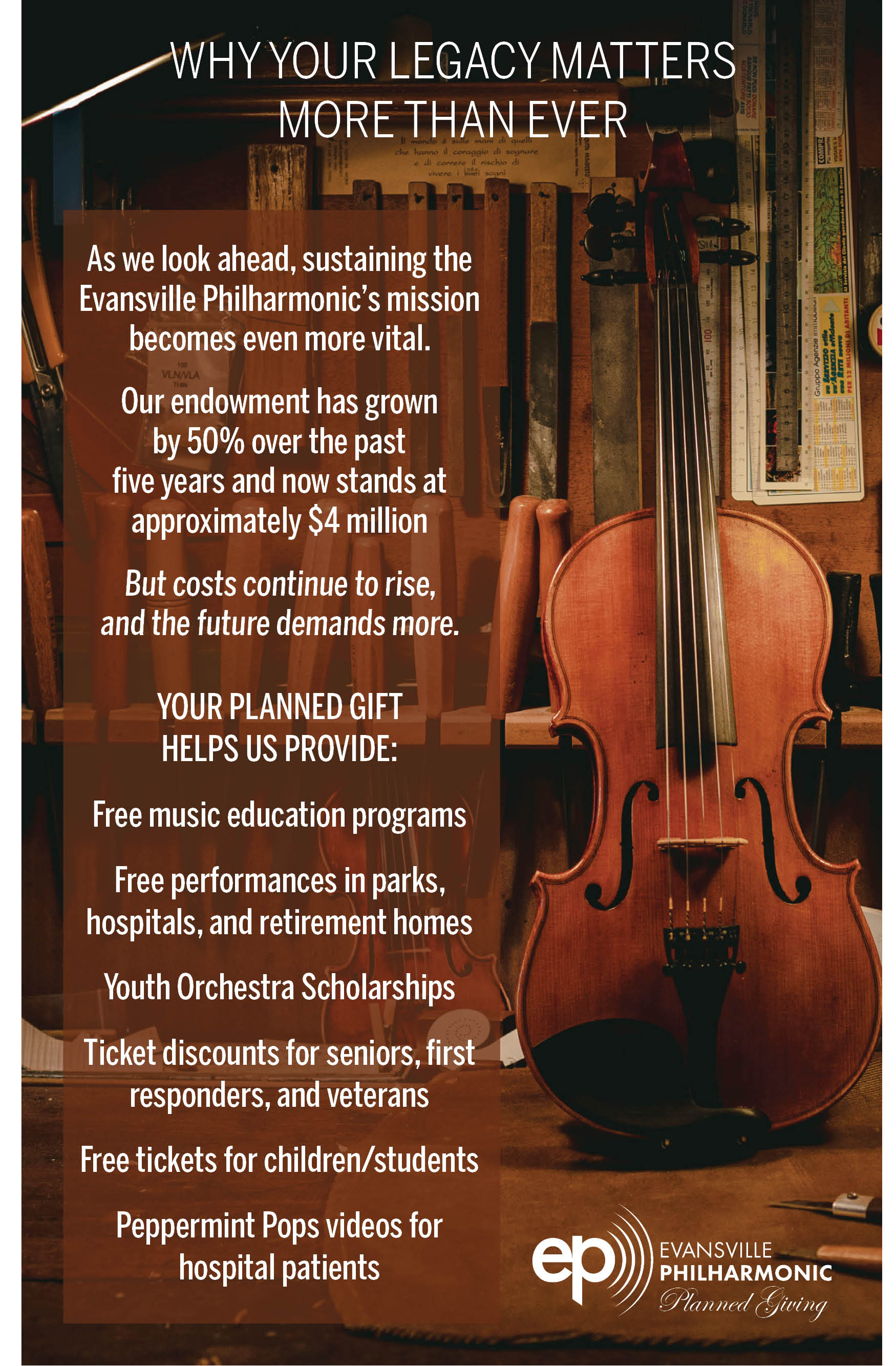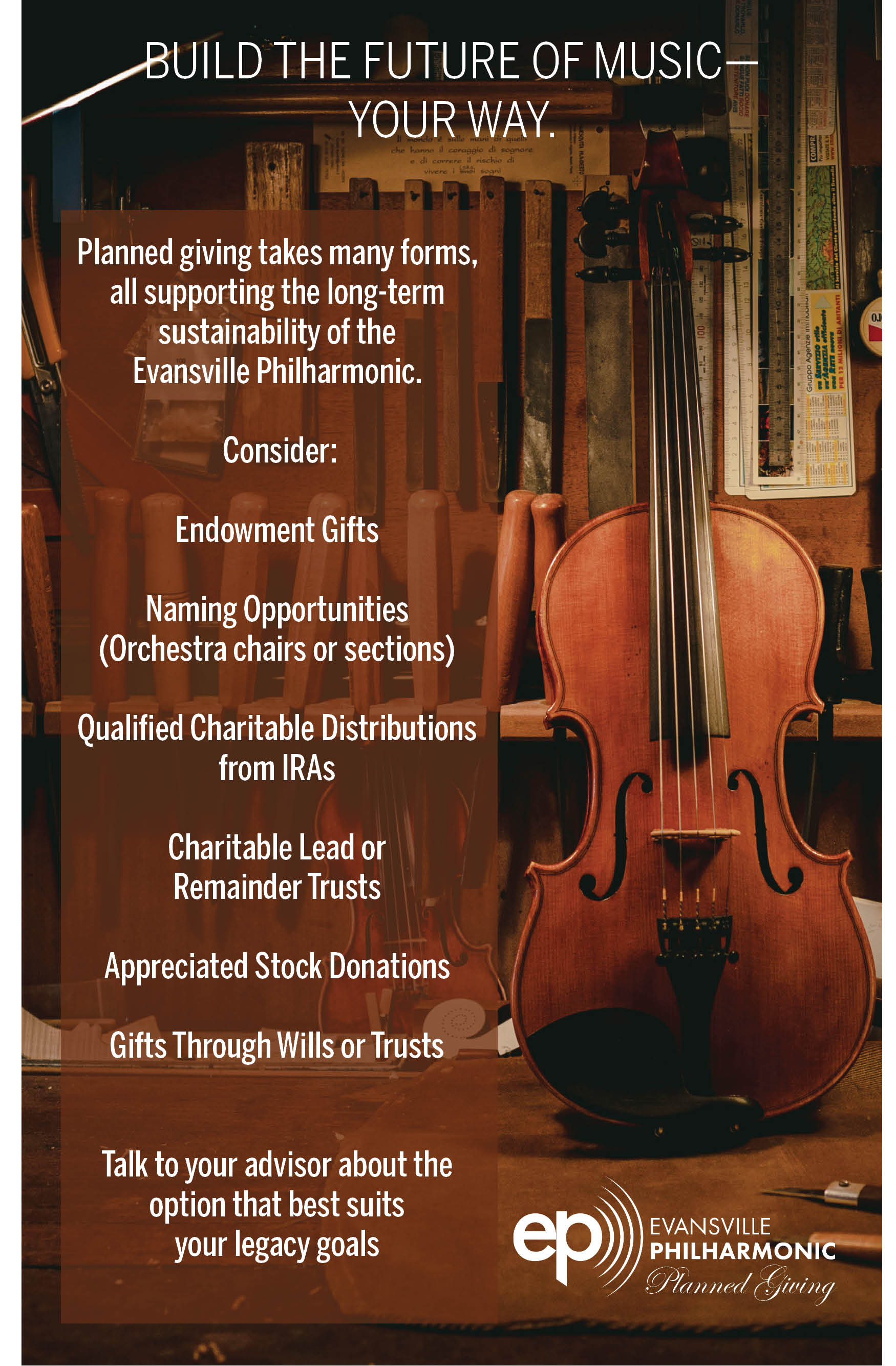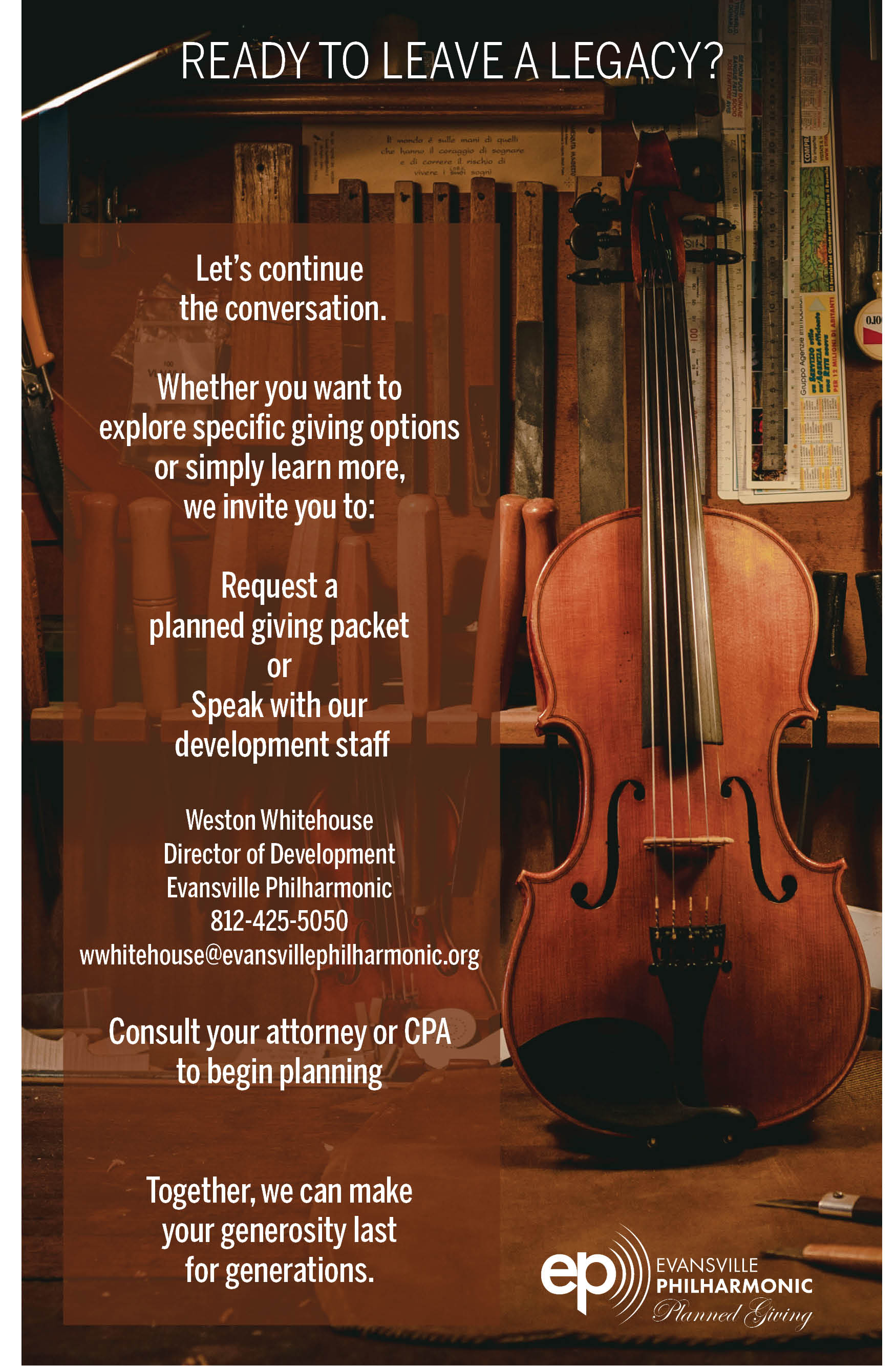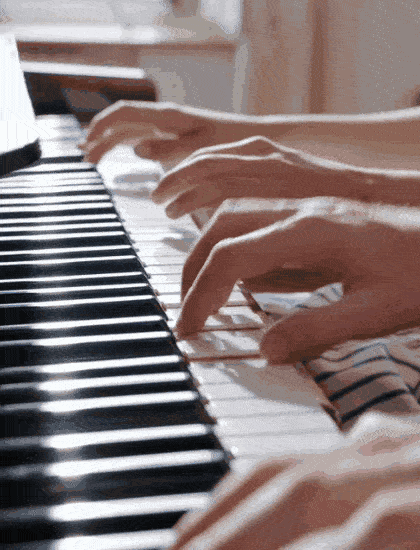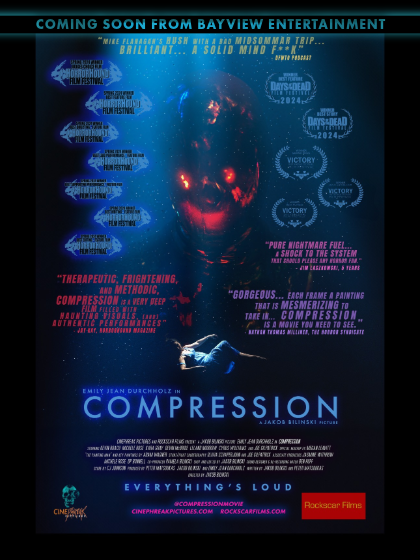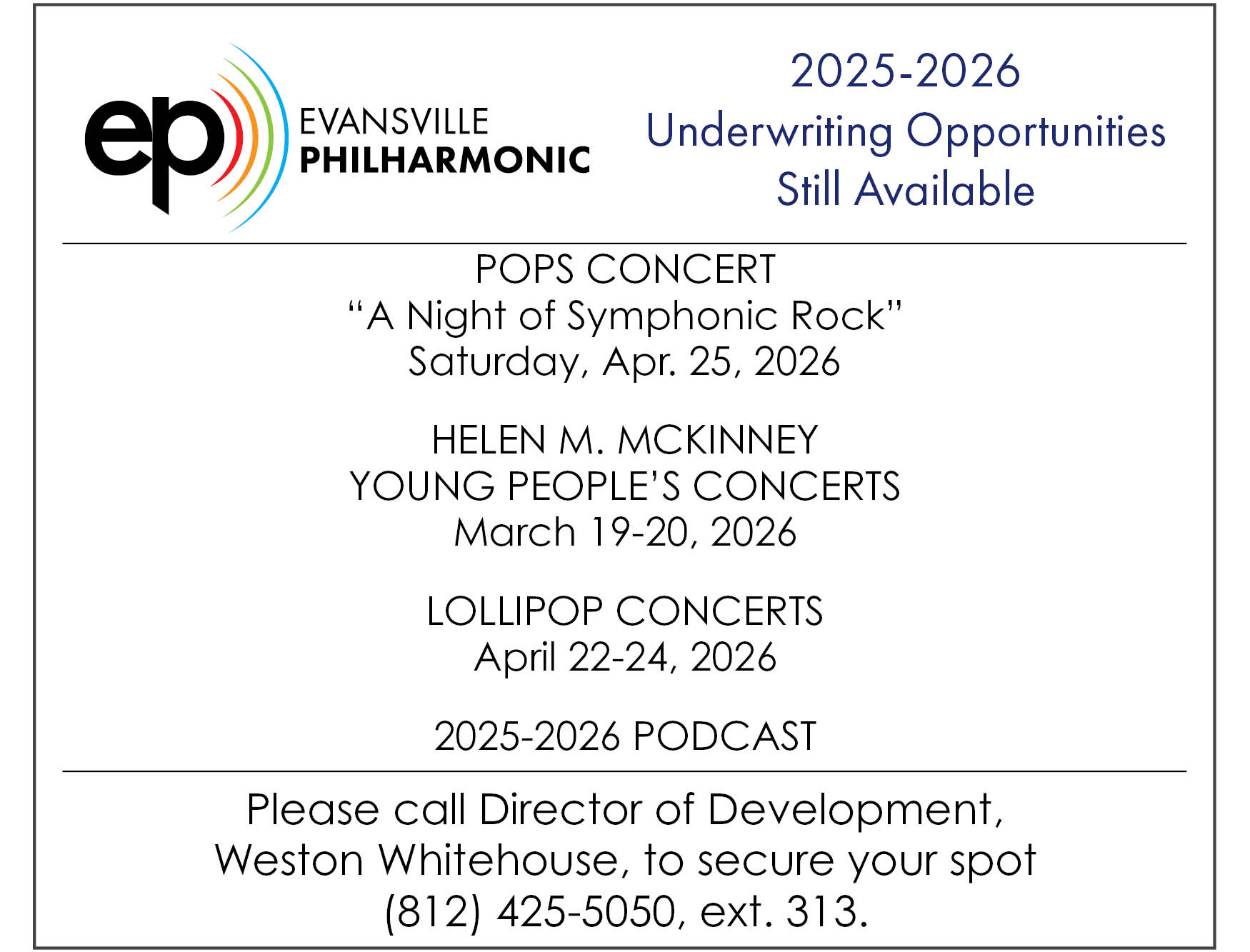

CONCERT SPONSOR |  | GUEST ARTIST SPONSOR |  | MUSIC SPONSOR |

EVANSVILLE PHILHARMONIC ORCHESTRA
Roger Kalia, Conductor | Demetrious Sampson, Jr., Tenor
ARTURO MÁRQUEZ | Conga del Fuego Nuevo | |
GIACOMO PUCCINI | “E lucevan le stelle” from Tosca | |
| UNDINE SMITH MOORE | “Martin’s Song” (Lord Thou Knowest) from Scenes from the Life of a Martyr | |
| PIETRO MASCAGNI | Intermezzo from Cavalleria Rusticana | |
| STEPHEN SONDHEIM | “Finishing the Hat” from Sunday in the Park with George | |
GEORGES BIZET | “Danse Boheme” from Carmen Suite No. 2 (1887) | |
| INTERMISSION | ||
GIUSEPPE VERDI | “La donna è mobile” from Rigoletto | |
CLAUDE-MICHEL SCHÖNBERG | “Bring Him Home” from Les Miserables | |
GIACOMO PUCCINI | “Nessun Dorma” from Turandot | |
IGOR STRAVINSKY | Firebird Suite (1919) | |
Official IT Services Provider
Official Photographer
Daniel Knight of Studio B Photography
Ticket Sponsor
Steinway is the official piano of the Evansville Philharmonic Orchestra
VIOLIN II
VIOLA
CELLO
BASS
FLUTE
OBOE
CLARINET
BASSOON
HORN
TRUMPET
TROMBONE
TUBA
TIMPANI
PERCUSSION
PIANO
HARP
SABBATICAL
RECORDING
STAGE PRODUCTION
*Eykamp String Quartet member
PROGRAM NOTES
Written by Bill Hemminger
CONGA DEL FUEGO NUEVO
ARTURO MÁRQUEZ
Duration: 4:30
Born in 1950, this Mexican composer studied in both Spain and Paris. He has always taken inspiration from Latin folk songs and dance rhythms, which is evident in tonight’s composition. The conga (which gave birth to the “conga line”) developed in Cuba and is characterized by the “1, 2, 3, kick” rhythmic impulse. As you might imagine, Márquez’s dance features a very active percussion section and a mariachi-like line for trumpets. The title translates as “Conga of the new fire.”
“E LUCEVAN LE STELLE” FROM TOSCA
GIACOMO PUCCINI
Duration: 3 Minutes
Puccini (1858-1924) is well-known to music-lovers, not only opera fans. This opera, completed in 1900, is one of his most famous, filled as it is with heart-rending drama and equally touching vocal writing. This aria comes from the third and final act of the opera. Cavaradossi, a painter who is in love with the beautiful singer Tosca, is imprisoned on the roof of a castle, where he may view the star-studded night sky as he waits for his execution. A somber clarinet solo introduces the aria, whose initial text states “and the stars were shining,” which has become the title. Cavaradossi—a challenging tenor role that requires both lyrical and dramatic qualities in his voice—recalls his love for Tosca (whom he will never see again and who will later kill herself) as he views the star-spangled night sky. He reflects that “Never was life so dear to me, no never” as the aria comes to its ineluctable conclusion.
“MARTIN’S SONG” FROM SCENES FROM THE LIFE OF A MARTYR
UNDINE SMITH MOORE
Duration: 4:30
Undine Smith (1904-89) was the granddaughter of slaves in rural Virginia. Thanks to prevailing racism at the time she could not attend local theatres or concert venues in her youth, but nonetheless her childhood was filled with music—at church and at her Virginia home—where she had her first instruction. An excellent student, she spent her undergraduate years at Fisk University, a historically black college in Nashville, Tennessee. She then went on to study at Teachers College at Columbia University—during the Harlem Renaissance—and later at the Manhattan School of Music. In the years that followed she taught at numerous universities, lecturing widely on black composers and their contributions to the musical landscape in the United States and compiling a list of her own musical compositions.
“Martin’s Song” is a stirring moment in Undine Smith’s 16-movement oratorio, Scenes from the Life of a Martyr, the composer’s tribute to Martin Luther King, Jr. and to the civil rights movement. The work was completed in 1981, when the composer was 77, and it was later orchestrated by Donald Rauscher. It was performed throughout the United States and recommended for a Pulitzer Prize. “Martin’s Song” begins with the words “Lord, thou knowest I have tried to live humbly. . .I have not sought fame.” The yearning text is complemented by a mournful vocal line, accompanied by fitful orchestration.
INTERMEZZO FROM CAVALLERIA RUSTICANA
PIETRO MASCAGNI
Duration: 3:30
Mascagni (1863-1945) included this interlude in this one-act opera, “Rustic Chivalry” in English. He entered the opera in a competition, which he won, and the opera was staged in 1890. The scene is Easter Sunday. Just before the quiet playing of the intermezzo, the audience learns that a spurned lover has run to tell neighbor Alfio that his wife has been carrying on with another man. Not an auspicious setting for a holy feast day.
The village square becomes quiet. The mellow intermezzo conjures up the peace of rural life; its chief tune is an echo of a hymn heard earlier. Nothing could be further from the sordid activities of the characters. Easter comes quietly to a close on the square, but the actions of the principal actors will soon result in death, a jarring departure from the evocation of Easter in the midst of the village.
“FINISHING THE HAT” FROM SUNDAY IN THE PARK WITH GEORGE
STEPHEN SONDHEIM
Duration: 4 Minutes
Sondheim’s 1984 musical was inspired by the famous pointillist painting by Georges Seurat, “A Sunday Afternoon on the Island of La Grande Jatte.” Sondheim (1930-2021) makes Seurat (AKA George) a character in the play; he is joined on stage by Dot, his model and mistress. The play makes the point that a relationship with an artist can be very difficult, and George self-consciously laments that in attending to his art he often neglects his lover. George has been sketching people in the park along the river Seine all day. Previously, Dot has dumped him for the more attentive though mundane but reliable Louis. George considers his life choices, how the vocation of art is demanding—of time, energy, attention—and how the artistic mission so little corresponds to people’s daily needs and wants. He considers the hat that he has been painting; the sketch must be completed. He recognizes that fulfillment in an artistic endeavor so often overshadows personal happiness but can bring great rewards of its own. Today, “Un après-midi sur l’île de La Grande Jatte” is one of the world’s most well-known canvasses. Interestingly enough, Sondheim’s 2010 memoir describing his lifetime artistic efforts and personal triumphs bears the name “Finishing the Hat.”
“MORGEN” FROM FOUR SONGS, OP. 27
RICHARD STRAUSS
Duration: 4:30
In 1894 Richard Strauss (1864-1949) set poetry of John Henry Mackay, a German citizen though of Scottish descent, to music. Originally written for piano and voice, “Morgen” (“Morning” or “Tomorrow”) was a wedding present for his wife. Throughout his life, it remained one of his favorite compositions. In 1897 he orchestrated the piece, which is hushed in its entirety. Not surprisingly, the final line of the poem reads “upon us will sink the mute silence of happiness.”
DANSE BOHÈME FROM CARMEN SUITE, NO. 2
GEORGES BIZET
Duration: 4:30
Concert hall favorites, two suites of compositions were created from Bizet’s 1875 opera Carmen. The composer’s friend Ernest Guirard assembled these suites posthumously (since Bizet died suddenly at a young age of 37 in 1875). The Danse Bohème (Bohemian dance) takes place in Lillas Pastia’s bar where gypsies and soldiers are gathered. Carmen and her two friends, Frasquita and Mercédès, are clacking castanets, singing sordidly and dancing wildly. On display is Carmen’s free and passionate nature; the room reverberates with excitement and energy—as does the composition.
“LA DONNA È MOBILE” FROM RIGOLETTO
GIUSEPPE VERDI
Duration: 2:30
Verdi (1813-1901) is certainly the doyen of 19th-century Italian opera. Tonight’s aria is one of his most famous and has been a showpiece for tenors for almost two centuries. The 1851 opera tells the tragic story of the Duke of Mantua, himself a notorious womanizer, his jester Rigoletto, and Rigoletto’s nubile daughter Gilda. In this aria at the beginning of Act III, Mantua proclaims his disregard for women and for their equivocal behavior. The words of the first stanza pretty much say it all: “Woman is flighty / Like a feather in the wind. . . .Yet one never feels / fully happy/ who from that bosom / does not drink love!” Of course, despite his fabulous voice and commanding presence, he is a rake as well as a wretched liar. He goes on to seduce Gilda, who, having fallen for him, kills herself when she discovers that her vengeful jester-father has arranged for the death of the Duke.
“BRING HIM HOME,” FROM LES MISÉRABLES
CLAUDE MICHEL SCHÖNBERG
Duration: 5 Minutes
This tune comes from Act II of Les Misérables, where students have barricaded the streets in Paris; it is the 1832 Paris uprising. Student Marius Pontmercy worries when he learns that his friend Éponine has disguised herself as a boy and has joined the rebels. Partly to remove her from the scene of impending fighting, Marius sends her to deliver a letter to Cosette, his lover. Meanwhile, Jean Valjean manages to intercept the letter and learns of the young lovers, who face a very uncertain future.
A battle between government forces and the defenders of the barricade begins. In this song, Valjean prays to God to protect Marius, whom he thinks of as his own son. He implores: “He is young; I am old / If I die, let me die” in his fervent hope that the life of the young man may be spared.
“NESSUN DORMA” FROM TURANDOT
GIACOMO PUCCINI
Duration: 4 Minutes
This aria appears at the end of Puccini’s final opera, which he had not finished at the time of his death in 1924. The story is expectedly convoluted; it takes place in a China that is ruled by a cruel but bewitchingly beautiful princess. Like the sphinx, she asks three questions of potential suitors. If they fail in any response they are put to death. Calaf, the tenor star, has correctly answered her requests, and she must therefore accept his proposal. But he has not revealed his name to her, so she demands that her people “not sleep tonight” until his name is revealed. But he saves the day—and the lives of the citizenry—by stepping up and announcing that his name is Love (a bit of a poetic lie) in a brilliant aria that Pavarotti made world famous in the 1990s.
“FIREBIRD SUITE”
IGOR STRAVINSKY
Duration: 23 Minutes
A pre-eminent 20th century Russian composer (1882-1971), Stravinsky stunned and shocked the musical world with his early ballet scores, The Firebird, Petrushka, and the Rite of Spring—all appearing in the 1910s. His music was a succès de scandale for its raw rhythmic vitality and shocking tonality—which entranced (most) European audiences. Tonight’s work is a suite taken from the much longer ballet; Stravinsky assembled it in 1919. The Suite comprises selections from the entire ballet score. The story line is based on the Russian legend of the Firebird, a stunningly beautiful, magical creature resembling a human. As the story begins, heroic Prince Ivan has strayed into a forest guarded by evil sorcerer Kastcheï (also spelled Kaschei, Koshei or Kotschei; transliterating Cyrillic is not automatic) and notices the Firebird, whom he chases and captures.
Pleading for her life, the Firebird promises to help the errant Prince if he releases her. He agrees but not until he has danced a fantastical pas de deux with her. The Prince continues his way and meets a number of princesses enchanted by the sorcerer; they populate the forest. Of course he falls in love with one, and naturally he decides he must rescue her. But he needs the help of the Firebird in order to counter the sorcerer’s spells. The Firebird bewitches the sorcerer’s captive minions, making them dance a wild, enervating dance, the “Infernal Dance.” The dancers collapse from exhaustion; Kastcheï’s spell is broken; and mysteriously the enchanted forest and its manager-magician disappear, leaving behind a bevy of princesses. Ivan may now rescue and marry Katerina, his chosen one.
- Podcast
- Conductor Biographies
- Bill Hemminger Biography
- Photos
- Videos
- Articles and Reviews
- Radio Broadcast Schedule
- History of the EPO
- Mission and Values
- Board of Directors 2025-2026
- Sponsors 2025-2026
- Philharmonic Gives Back
- Donors 10/1/2024 - 10/1/2025
- Thoughtful Tributes 10/1/2024 - 10/1/2025
- Past Events




